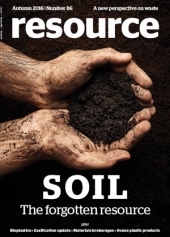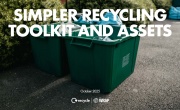Charting the bioplastics boom
Swapping out the oil-based plastics we all know and love (or hate, as the case may be) for ones derived from things like seeds may seem like a new-fangled idea, but the concept has been around as long as man-made plastics themselves. In 1862, Alexander Parkes patented Parkesine, made from cellulose treated with nitric acid. The venture went out of business after two years, but the idea of utilising surplus crops or other biobased sources to make solid industrial materials has never gone away.
Henry Ford himself was an advocate, and in the 1930s used a soy plastic for steering wheels, panels and trim, even unveiling an entirely ‘Soybean Car’ (barring the steel frame) at a festival in 1941 – an experiment curtailed by World War II. Petrol-based plastics, first seen in 1907, boomed following the war, a growth that has yet to be slowed. But the desire for a greener alternative has remained, and today bioplastics represent a rapidly growing industry.

The term bioplastics covers a variety of materials made in part, or totally, by polymerising things like natural sugars, oils and fibres from renewable resources. The term ‘bioplastic’, then, is a broad church, including plant-based materials that biodegrade (polylactic acid (PLA), and polyhydroxyalkanoates (PHA)), or are simply biobased (using ‘drop-in’ chemicals to make materials like polypropylene (PP) or polyethylene terephthalate (PET)).
The materials are further categorised by generations, and by identifying their renewable content. As processes develop, producers are increasingly able to replace more petrol-based feedstocks, and so the industry has gone from materials with around 10-15 per cent renewable content to (in at least one case – Novamont’s fourth-generation Mater-Bi) ones with over 60 per cent.
Are they actually better?
The advantages of bioplastics vary with their nature. As David Newman, Managing Director of the Bio-based and Biodegradable Industries Association (BBIA), says: “It’s a big family, and bioplastics are therefore to be looked at as materials for specific use rather than just a plastic substitute.”
However, he offers up three general advantages to bioplastics. The first is the sourcing of the material. Using renewable feedstocks over waning sources of fossil fuels carries obvious advantages for resource supply (so long as those feedstocks are themselves sustainable and gathering them doesn’t displace food crops, for example), and it can also enable a more local operation. Italian biochemical giant Novamont, for example, operates a facility in Sardinia where local farmers supply thistles grown on less arable land, from which both the oil and biomass are used to create products.
“The second advantage is that it’s cleaner to use”, says Newman. “It’s less harmful to the environment if it falls into it, and it’s less harmful to human health both in the manufacturing process and in the use of the material.”

The third potential advantage for some of these products is biodegradability. Biodegradable films (certified as suitable for composting – which in Europe means complying with the EN13432 standard and breaking down in up to 180 days) can be used to enourage and enable food waste collections, says Newman. With food waste at once a huge environmental problem and a great opportunity for boosting recycling rates, compostable plastics that can be safely included in collections and treatment offer an attractive solution.
“Flexible compostable plastics play a potentially huge role in getting that food waste back to soil,” says Newman, “and that’s where its success has been in countries like France and Italy, using these materials to get food waste back to clean treatment systems, closing the soil-to-soil loop.”
In Milan, for example, retailers’ carrier bags must be compostable, providing a handy crossover with food waste collection, as they can then be used as bin liners and composted with the food waste. Since the changes were introduced, the quality of organic waste has improved greatly.
Environmental benefits are all well and good, but when biodegradability isn’t a focus (or even a desired trait), bioplastics need something else to hang their hat on to crack big business. Sokhna Gueye, Packaging Environmental Sustainability Specialist for Nestlé, says that the consumer giant sees no advantage in biodegradability for its packaging: “If you tell the consumers the packaging is biodegradable they think they can throw it away and it disappears the next morning, which is not the case.”
However, other forms of bioplastics are becoming more attractive to companies like Nestlé, which doesn’t necessarily want biodegradable packaging, but rather a biobased material that can slot in with current process (and which, in theory, can be recycled with petrol-based plastics), or perhaps even exceed conventional plastics’ performance. “The first generation of materials such as PLA are moisture sensitive, and we are a dry food company and need to keep moisture out, but there are products for which it makes sense: PLA is a perfect aroma barrier and can be a good material for yoghurt cups. Generation two are the drop-in materials, so can be exactly what we are using today, with exactly the same properties, but without the fossil-based composition.
“The third generation is really what we are aiming at: material that has enhanced performance, for which we can make sure that we don’t have any contributions to food insecurity.” Indeed, just because something comes from a renewable resource doesn’t mean it’s environmentally beneficial, and the impact of producing biobased products must be considered. WWF’s Bioplastic Feedstock Alliance includes some of the world’s largest consumer goods producers (Coca-Cola, Nestlé and Unilever, to name a few) and works to guide the responsible sourcing. Gueye explains: “When we consider bioplastics compared to fossil-based plastics, we aren’t focusing only on greenhouse gas emissions. We also look at the impact on land use, water and biodiversity to make sure that we are not shifting burdens. Whenever we are considering bioplastics also we will go and check locally where the feedstock is coming from.”
 Fibres from tequila producer Jose Cuervo's used agave plants are being used by Ford to make rigid plastics
Photo: Ford Motor Company
Fibres from tequila producer Jose Cuervo's used agave plants are being used by Ford to make rigid plastics
Photo: Ford Motor Company

The growing market
Although Hasso von Pogrell, Managing Director of trade association European Bioplastics, suggests that, in theory, bioplastics could completely replace conventional plastics right now, they currently represent around one per cent of the 300 million tonnes of plastic used annually. However, as generations progress and suitable applications become available, this market is growing exponentially. European Bioplastics expects the global production capacity for bioplastics to grow from 1.7 million tonnes in 2014 to 7.8 million tonnes by 2019, while a Research and Markets report forecasts the market will grow at a compound annual rate of 29.3 per cent between 2016 and 2020.
Much of this growth is down to increased demand for non-biodegradable biobased plastics like polyethylene (PE) and PET (the ‘drop-in’ second generation Gueye refers to), which made up 60 per cent of global bioplastics capacity in 2014 but by 2019 will likely represent over 80 per cent. Katrin Schwede from European Bioplastics says that the “lion’s share” of bioplastics production is focused on PET, which is mainly used in packaging applications such as bottles.
“That makes packaging the largest market segment for bioplastics at the moment. But it’s not only the PET – a lot of the biodegradable materials are very suitable for food packaging or biodegradable bags or biodegradable tableware.” This is, of course, only true if the biodegradable plastics are kept out of the conventional plastic recycling stream, as otherwise they could have a detrimental effect on reprocessors’ operations.
Markets are, moreover, hard to predict: we suggested in Resource 58 (Spring 2011) that the cost of crude oil would continue to rise, eliminating a major bioplastic barrier. With oil prices falling, that issue of cost, at least in the short term, is still a hurdle restraining growth, and Gueye suggests that demand for greener products is not yet so great that consumers are willing to pay more: “Most of the time, consumers are not ready to pay more just because it’s biobased packaging – they are buying our products for the product, not for the packaging.”
But as the industry scales up, this cost gap will diminish. Schwede says: “We already see that prices of a lot of biobased plastics have fallen drastically in recent years, with higher volumes being produced and sold on the market as well as innovations. PLA, for example, can already be offered at very competitive prices.”
And Gueye adds that companies can themselves help by working together: “We are ready to pay more at the beginning if we see a way forward to get closer to the fossil-based polymer. We’re partnering with other food manufacturers because we cannot be the only ones using a novel material that has the potential to further improve the environmental performance. It has to be widely available to bring the cost down."
Taking the next step
The market for bioplastics is clearly growing and, as Gueye attests, many of the world’s biggest brands see them playing a large role in their future: “If we have bioplastics in our roadmap, it’s because we believe it’s a potential solution.” Both Newman and European Bioplastics, though, say that the driver for growth must come from outside the industry. “In the waste industry and in many new industries, government regulations are a game-changer”, says Newman. “Look at the laws in Italy. That sort of driver has meant that we’ve gone from zero to 100,000 tonnes of compostable plastics in five years.” In the last year, moreover, France has banned plastic carrier bags and disposable plates, cutlery and cups. Since July, carrier bags there must contain 30 per cent renewable material, increasing to 50 per cent in 2020 and 60 per cent in 2025. The government predicts the moves will also create 6,000 new jobs in the country.

Here in the UK, Newman points out that biobased research centres are making “wonderful discoveries”, but “all the guys are getting up and going to the US to build their factories, because the markets there have given a boost to the sector by preferring to purchase biobased materials”. He adds: “What stimulated companies like Novamont to go to Italy was the guaranteed audience they had early on. It was that volume – on its own about 40,000 tonnes a year – that meant companies could actually start investing. They then used those same biopolymers to make lots of other things, from lubricants to textiles for a whole series of construction materials and chemical building blocks for other industrial uses. It was that sort of certainty with the market that allowed you to go from small-scale to large-scale.”
Schwede adds: “There is nothing that bioplastics can’t do; the hurdles are based on a lack of policy to support market penetration.” She has a veritable shopping list of policies to help bioplastics “gain a stronger foothold in the European industry”: more support for the uptake of biobased materials in applications, inclusion of renewable and recyclable feedstock in ecodesign guidelines, a “level playing field” between the different segments of the bioeconomy to ensure secure supply to feedstocks for all, and, “most importantly”, the improvement of the waste management infrastructure in Europe.
The European Union’s Circular Economy Package has already noted that ‘biobased materials present advantages due to their renewability, biodegradability and compostability’. A positive sign, but national policy is key – green public procurement, for example, like the USA’s BioPreferred programme, created in 2002 and expanded in 2014, which requires all federal agencies to purchasebiobased productsin 97 categories including carpets, disposable tableware and cleaning products. “That’s given rise to an industry of some hundreds of millions of dollars”, says Newman.
But are there barriers to be overcome within industry too? Critics suggest end-of-life complications would cloud the benefit of bioplastics, a claim von Pogrell calls a “big myth”, stating that polymers are already sorted by type and that contamination is more common the other way round, with plastic bags being used to dispose of organic waste.
 This article was taken from Issue 86
This article was taken from Issue 86Edward Kosior, Managing Director of plastic recycling consultancy Nextek, though, says that this is an oversimplification, especially for films. “The truth is that films are rarely sorted by polymer type. As most films are PE they tend to be sorted by physical techniques that identify the 2D nature of the material without splitting into polymer types. This is why it is a big issue at least in principle, even though the relatively small volume of bioplastics means that this is not a statistically big problem.”
While some biobased polymers like bio-sourced PE are identical to the conventional material, Kosior notes that many other biopolymers based on sugar, starch and cellulose are not miscible with PE. Further, he says, biodegradable bioplastics typically require pre-drying before processing (PE does not) and typically degrade at relatively low temperatures “causing visible and physical deterioration of the recycled product”. He adds that the presence of even a little will create problems in a blend or even in 100 per cent bioplastic streams due to the lack of thermal stability compared to petro-plastics.
So, there’s still work to be done, but, as Newman says, the industry is always finding new ways to improve. While several years ago bioplastics were great for simple markets, he says, they’ve become more and more sophisticated. One exciting field is the development of rigid bioplastics, particularly those being used in automobile companies like Jaguar Land Rover, Honda and Ford, which “actually perform better than conventional plastics”, while making cars lighter and more fuel efficient. It seems like Henry Ford was on to something. 












